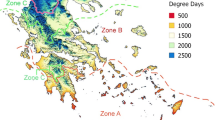Abstract
Relationships between environmental and social factors have long been studied by geographers. Nowadays, GIS-aided statistical analysis provides new tools to explore these relationships. In order to detect the impact of topography on social factors, we selected the country of Montenegro as a case example due to its high topographic variability. We compared the spatial pattern of population, settlements and ethnic minorities to physical geographic factors, especially to topography, but lithology and land cover data were also taken into consideration. We found that certain factors are closely correlated, e.g. the settlement density linearly decreases with elevation, while the characteristic settlement area shows an exponential increase upwards. The population density is not related to absolute elevation, but it is in close correlation with height (i.e. elevation relative to the local minimum). Population change and illiteracy are also topography-related social factors. On the contrary, the variable ethnic pattern of Montenegro is influenced by historical, political and economic effects rather than by environmental factors or topographic features. As a conclusion we state that in the scale of a country or a region, the environment can strongly impact some social factors.
Similar content being viewed by others
References
AMS (1954) Topographic Maps 1:250 000 (NK 34-1, NK 34-2, NK 34-4, NK 34-5, NK 34-7). Army Map Service, Corps of Engineers, US Army, Washington, D.C.
Ballinger C (2011) Why Geographic Factors are Necessary in Development Studies. Social Science Research Network: http://ssrn.com/abstract=1791127 p 41 (Accessed on 2013-10-21).
Bottlik Zs (2008) Geographische Hintergründe zur nationalen Identität der Montenegriener. Geographische Rundschau 60(10): 54–61.
Bottlik Zs (2009) Geographical and historical aspects of the situation of Muslim population in the Balkans. Hungarian Geographical Bulletin 58(4): 257–280.
Brunnbauer U (2002) Families and mountains in the Balkans. Christian and Muslim household structures in the Rhodopes, 19th-20th century. History of the family 7(3): 327–350. DOI:10.1016/S1081-602X(02)00107-0
Büttner Gy, Feranec J, Jaffrain G, Mari L, Maucha G, Soukup T (2004) The CORINE Land Cover 2000 Project. EARSeL eProceedings 3(3): 331–346.
Büttner Gy, Kosztra B, Sousa A, Steenmans C (2010) CLC2006: Mapping Land Cover of Europe under GMES 26–34. In: Kalaitzidis C, Manakos I (eds.) Imagin[e,g] Europe: Proceedings of the 29th Symposium of the European Association of Remote Sensing Laboratories, Chania, Greece. p 460. DOI:10.3233/978-1-60750-494-8-26
Cohen JE, Small C (1998) Hypsographic demography: The distribution of human population by altitude. Proceedings of the National Academy of Sciences of the USA 95: 14009–14014. DOI:10.1073/pnas.95.24.14009
Diamond J (1997) Guns, Germs, and Steel: The Fates of Human Societies. W.W. Norton & Company, NewYork. p 460.
Feng W, Li A, Zhou W (2007) Spatial Pattern of Rural Settlements in the Upper Reaches of the Minjiang River — a Case Study in Maoxian County, Sichuan. Journal of Mountain Science 4(2): 146–154. DOI: 10.1007/s11629-007-0146-9
Geokarta (1980) Crna Gora. Administrativna Podjela. 1:300 000. Zavod za kartografiji “Geokarta”, Belgrade, 1980. GoogleMaps: http://maps.google.hu/ (Accessed on 2013-10-21)
Hammond EH (1964) Analysis of properties in landform geography: An application to broadscale landform mapping. Annals of Association of American Geographers 54: 11–19. DOI:10.1111/j.1467-8306.1964.tb00470.x
Lovász Gy, Gyenizse P (2012) Impact of Karst Development on Settlement Network in Hungary and Croatia. Karst Development 2(1): 21–28.
McGranahan DA (2008) Landscape influence on recent rural migration in the U.S. Landscape and Urban Planning 85: 228–240. DOI:10.1016/j.landurbplan.2007.12.001
Milošević MV, Milivojević M, Ćalić J (2010) Spontaneously abandoned settlements in Serbia, Part 1. Journal of the Geographical Institute “Jovan Cvijić” SASA 60(2): 39–57. DOI:10.2298/IJGI1002039M
Milošević MV, Milivojević M, Ćalić J (2011) Spontaneously abandoned settlements in Serbia, Part 2. Journal of the Geographical Institute “Jovan Cvijić” SASA 61(2): 25–35. DOI:10.2298/IJGI1102025M
MONSTAT (2003) Census of Population, Households and Dwellings 2003, Population. National or Ethnic Affiliation (Data by Settlement and Municipalities). MONSTAT (Statistical Office of Montenegro), Podgorica.
Rabus B, Eineder M, Roth A, Bamler R (2003) The shuttle radar topography mission — a new class of digital elevation models acquired by spaceborne radar, Photogramm. Rem. Sens. 57: 241–262. DOI: 10.1016/S0924-2716(02)00124-7
Savezni Geološki Zavod Jugoslavija (1970) SFR Jugoslavija, Geološka Karta 1:500 000. Savezni Geološki Zavod (Federal Geological Institute), Beograd.
Sluyter A (2003) Neo-Environmental Determinism, Intellectual Damage Control, and Nature/Society Science. Antipode 35(4): 813–817. DOI:10.1046/j.1467-8330.2003.00354.x
Small C, Cohen JE (2004) Continental Physiography, Climate and the Global Distribution of Human Population. Current Anthropology 45(2): 269–277. DOI: 10.1086/382255
Viles H (2004) A Divided Discipline? 26–38. In: Castree N, Rogers A, Sherman D. (eds.) Questioning Geography. Fundamental Debates. Blackwell Publishing, Oxford, UK. p 314.
Vukićević I (2012) Ethnic composition of Montenegro 1948–2011. Faculty of Organizational Sciences from Belgrade. Manuscript. p 34.
Author information
Authors and Affiliations
Corresponding author
Rights and permissions
About this article
Cite this article
Telbisz, T., Bottlik, Z., Mari, L. et al. The impact of topography on social factors, a case study of Montenegro. J. Mt. Sci. 11, 131–141 (2014). https://doi.org/10.1007/s11629-012-2623-z
Received:
Accepted:
Published:
Issue Date:
DOI: https://doi.org/10.1007/s11629-012-2623-z




